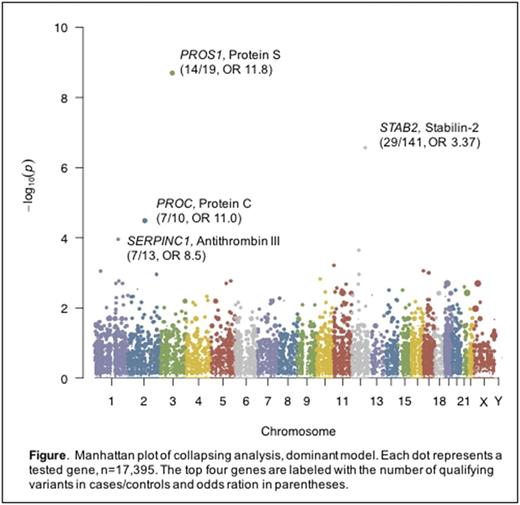Abstract
Deep vein thrombosis and pulmonary embolism, collectively referred to as venous thromboembolism (VTE), are the third leading cause of cardiovascular death in the United States. Genetic factors account for 50-60% of VTE risk and a recent meta-analysis of genome-wide association studies confirmed that common variants in F5, ABO, F2 and seven other very low effect size loci are associated with VTE. Rare mutations in the anticoagulant genes PROC (protein C), PROS1 (protein S) and SERPINC1 (antithrombin III) have been linked to highly penetrant VTE risk in family studies but no genome-wide study of rare variants has been reported to date.
We performed whole exome sequencing (WES) in 373 unrelated individuals of European ancestry with well characterized unprovoked VTE and compared results to a previously genome sequenced control cohort of 5784 unrelated Europeans. We then identified single nucleotide variants, small insertion or deletions that were present at allele frequencies less than 0.005% in ExAC and had equal sequencing coverage between groups. Using a dominant model and a collapsing association analysis, we looked for genes that were more likely to harbor "knockout" (frame shift, nonsense, splice site and damaging missense) mutations in cases versus controls. Strikingly, ranked by p-value, among 17,395 genes tested, the top 4 genes were PROS1 (P= 2.01E-09, odds ratio: 11.8), STAB2 (P=2.70E-7, odds ratio 3.37), PROC (P=3.24E-05, odds ratio 11.0) and SERPINC1 (P=1.10E-04, odds ratio 8.5), Figure. These findings suggest that heterozygous deficiency for the STAB2 encoded protein, stabilin-2, confers VTE susceptibility similar to the previously well described phenotypes of heterozygous protein C, protein S and antithrombin III deficiency.
Stabilin-2 is a single transmembrane glycoprotein scavenger receptor expressed on venous endothelium of liver sinusoids and spleen. We detected damaging STAB2 mutations in 29 (7%) VTE cases versus 141 (2%) of controls. Common and uncommon variants in STAB2 have been associated with elevated plasma von Willebrand factor (VWF) and coagulation factor VIII levels, which are known risk factors for VTE. Stabilin-2 is implicated as a clearance receptor for VWF, so that haploinsufficiency of stabilin-2 may increase plasma VWF half-life. To test this hypothesis, we examined 1162 individuals in the Twins UK Study (VTE status unknown) with available whole genome sequencing data and measured their plasma VWF levels by AlphaLISA. VWF levels were adjusted by log transformation and ABO blood type tagging SNPs. We identified 38 individuals (3.2%, all heterozygous) with rare damaging variants in STAB2. VWF levels were significantly higher in individuals (N=30) with rare STAB2 variants compared to those without (N=1016) (Mann-Whitney, P= 0.0046).
To further examine stabilin-2 function in vivo, we compared Stab2 deficient mice (Stab2 -/-) to wild type (Stab2 +/+) controls. Stab2 -/- mice had elevated plasma levels of factor VIII:C (118%, p=0.0006), but no differences in VWF (p=0.58). Next, we examined thrombosis in a mouse model where venous blood clotting was induced by inferior vena cava stenosis. Thrombi were weighed and longitudinal sections were analyzed by quantitative immunohistochemistry 24 hours post-stenosis. Stab2 -/- mice developed significantly larger thrombi than Stab2 +/+ mice (194%, n=19, p=0.003) but no difference in DVT incidence (64% vs 61%, P= 0.85). Despite equivalent hematocrit (P= 0.91) and white type thrombus (P> 0.05), thrombi from Stab2 -/- mice were comprised of more red type thrombus (185%, P= 0.004).
Through an unbiased analysis of whole exome sequencing in 6,157 individuals, this studyconfirms the role of haploinsufficiency of PROC, PROS1 and SERPINC1 for VTE susceptibility and identifies STAB2 deficiency as a potential new risk factor. Analysis of an independent human cohort of 1162 Europeans demonstrates that STAB2 haploinsufficiency is associated with elevated VWF levels, a known risk factor for VTE. Finally, a mouse model of Stab2 deficiency demonstrates enhanced thrombosis, though without an association with elevated VWF levels. Taken together, these results suggest that rare genetic variants in STAB2 collectively play a role in individuals with unprovoked VTE by prolonging the plasma half-life of procoagulant factors such as VWF, adding an important new gene to the short list of known risk factors for this common disease.
Reitsma: Leiden University Medical Center; VarmX B.V.: Equity Ownership, Patents & Royalties: co-inventor on a patent application related to this abstract.
Author notes
Asterisk with author names denotes non-ASH members.


This feature is available to Subscribers Only
Sign In or Create an Account Close Modal